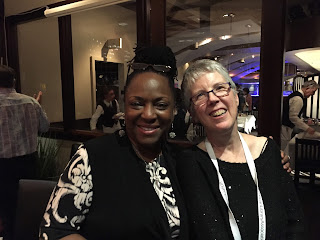This year was another banner year of author and illustrator visits, and a number of the books highlighted at this year's programs have received critical acclaim on "best of the year" lists issued by professional review magazines (Kirkus, School Library Journal, Publisher's Weekly) as well as the New York Public Library and the Chicago Public Library. This year, the Evanston (Ill.) Public Library also has created a "best books" list thanks to the indefatiguable kidlit blogger Betsy Bird, who moved from NYPL to the Evanston Public Library a couple of years ago and some of our visiting authors and illustrators made that list. Several also made the "best books" offered by The Washington Post, as well as The New York Times, which does both a Notable Children's Book list and a 10 Best Illustrated Children's Books list.
So, if you're looking for some great holiday gifts for young readers, start by checking out the books by our visiting authors and illustrators that were chosen as best books of the year! Here's the list, with the books presented by age and then alphabetically by title. (The key to the "best books" lists: CPL is Chicago Public Library; EPL, Evanston Public Library; K is Kirkus; NYPL is New York Public Library; NYT is New York Times; PW is Publisher's Weekly; SLJ is School Library Journal; and WP is Washington Post ).
PICTURE BOOKS:
__ A Greyhound, A Groundhog, written by Emily Jenkins and illustrated by Chris Applehans. (K)
Emily visited our library in February to present this gracefully-written book with quietly stunning illustrations.
__ All the Way to Havana, written by Margarita Engle and illustrated by Mike Curato. (K, EPL).
Mike came on his own to present the book, after Margarita got sick and had to cancel. No matter, Mike did a great job explaining how he did the research for this book focused on a family's road trip to visit relatives in an old, but trusty blue car.
__ Creepy Pair of Underwear, written by Aaron Reynolds and illustrated by Peter Brown. (K)
Peter paid us a return visit (he first came a year ago) to read this hilarious sequel to the Caldecott Honor-winning Creepy Carrots. (Kids at our program especially loved that Peter signed copies of the book with a silver Sharpie so that his signature would stand out on the black title page.)
__ Lucia the Luchadora, written by Cynthia Lenor Garza and illustrated by Alyssa Bermudez.(CPL, EPL, K)
Who says girls can't be superheroes? Lucia takes her classmates by storm when she dons the disguise of a luchadora; soon everyone wants to be part of the Mexican lucha libre tradition. Cynthia came this spring to read the book and answer questions about luchadoras.
GRAPHIC NOVELS:
__ Castle in the Stars: The Space Race of 1869, written and illustrated by Alex Alice. (K)
Alex, who hails from France, held the crowd spellbound with his tales of how he came to write this dense and lushly illustrated adventure tale, the first in a series. Featuring hot air balloons, a Bavarian castle and dastardly villains, Alex's book will have you quickly turning pages to see what happens next. If you read French, you can read the second book, which was published earlier this year in France. Otherwise you'll have to wait a year or two, when the English version is published, to see what happens next!
__ Good Night, Planet, written and illustrated by Liniers. (CPL, K, NYT)
Liniers, an internationally known Argentinian cartoonist, has turned his talent to creating graphic novels for beginning readers. In this charming book, he depicts the antics of Planet, a stuffed fawn, and real dog named Elliott after their human family has gone to sleep.
__ Pashmina, written and illustrated by Nidhi Chanani. (CPL).
Nidhi mixes fantasy and realism in this debut book about a teen who is frustrated by her mother's refusal to say why she moved, with her baby daughter, from India to California. When Priyanka finally gets to go to India herself, she begins to understand her mother's courage. At our event, Nidhi did some live drawing and talked about her graphic work for Disney and others.
MIDDLE GRADE NOVELS:
__ Amina's Voice, written by Hena Khan. (CPL, K)
Amina is a middle schooler whose main concerns revolve around friends and school until her beloved mosque is vandalized. In her program at the library, Hena talked about how her timely debut novel is the kind of realistic fiction she liked to read as a child.
__ wishtree, written by Katherine Applegate. (CPL, PW, NYT, WP)
Trees can not only talk, they can help make things better, with some help from humans in the world of this lyrically-written novel. Katherine, who won a Newbery Medal for The One and Only Ivan, presented the book at a program where she had kids both laughing and thinking about what's important in their lives.
NON-FICTION:
__ Marti's Song For Freedom/Marti u Sus Versos por La Libertad, written by Emma Otheguy and illustrated by Beatriz Vidal. (K, NYPL, SLJ)
In her program, Emma talked about the importance of Cuban freedom fighter Jose Marti in her life and in the lives of generations of Cuban-Americans. Her beautifully-illustrated book uses Marti's poetry to illuminate the many twists and turns in his inspiring life.
And one more! This event hasn't happened yet, but the book -- Before She Was Harriet -- already has gotten lots of great reviews and is on three "best books" lists: CPL, EPL, SLJ. So mark your calendars for Thursday, Feb. 8 at 7 p.m. when author Lesa Cline-Ransome and her illustrator husband James Ransome will talk about their picture book biography of Harriet Tubman.
END NOTES: Thanks to the P&P folks -- especially Margaret Orto, children's & teen events coordinator -- for making it possible for my library to host these programs with outstanding children's authors and illustrators!



















































